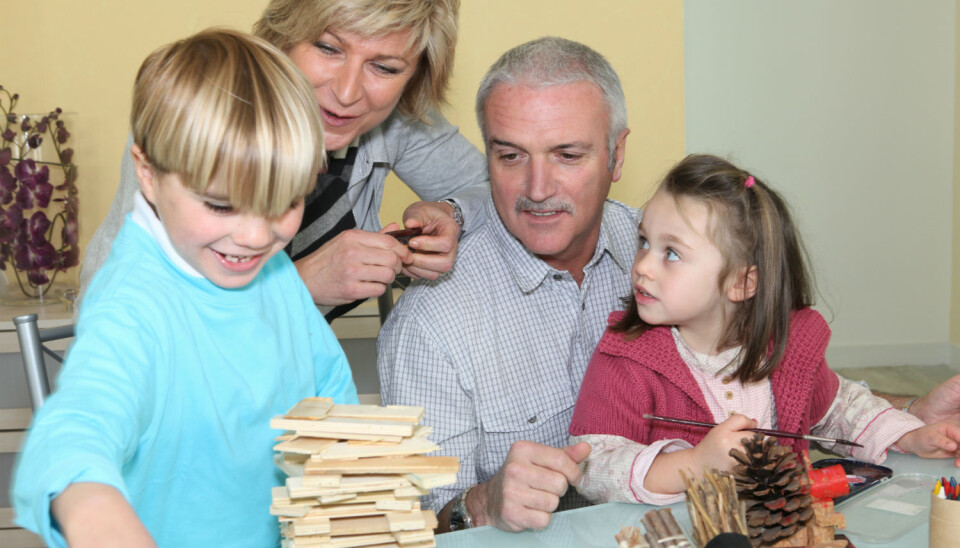This article was produced and financed by Oslo Metropolitan University

How grandparents fit into modern family life
Parents and adult children live close to one another, stay in close contact and help each other. However, children mean more to parents than the other way around.
We spend most of our lives in families with three generations or more. It is about high time that this is reflected in research and policy, which traditionally has addressed families with young children.
Katharina Herlofson and Svein Olav Daatland make this claim in the NOVA-report named “Research on family generations: A state of the art report”.
The researchers have gone through existing research about intergenerational family relationship and concludes that the ‘modified extended family’ holds center stage – even in the lives of modern people.
Grandparents involve themselves in looking after grandchildren, adult children contribute substantially to the care of elderly parents, and much company, comfort and support flow between the generations, perhaps more than ever.
“The media likes to tell stories of a modern family in crisis and about conflicts between generations, but our findings do not confirm this picture, rather the contrary,” Herlofson explains.
Live close to each other
Multigenerational households are not common in Norway, but the generations often live close to one another, she stresses. 80% of older parents have at least one child living within a radius of 50 km, and both younger and older generations seem to prefer it this way. They want their family close, but not too close.
The generations stay in close contact with each other: More than 6 out of 10 parents spend time with their adult children every week or even more frequently, which is about the same level as found in research done in the 1960s.
Also, family generations stay in contact via telephone, there is, which is far cheaper today than it used to be. And the technological development has opened up possibilities for contact that did not exist before, such as e-mail and Skype.
Parents experience the relationship as closer than adult children
The relationship between parents and adult children is also experienced as emotionally close, but parents have a tendency of reporting closer ties than children do. The children seem to matter more to the parents than the other way around.
If one has to prioritize, people tend to prioritize down the generational line, Daatland emphasizes.
Help and support also tend to be passed down from older to younger generations in the family, at least until the parents reach their seventies. After that, the younger more often help the older generation.
Grandparents as ‘emergency assistance’
Grandparents are an important source of support for families with young children. They serve as a sort of ‘emergency assistance’ when and if there is a need.
In Norway, the need for daily assistance is almost non-existent because of the availability of extensive public childcare and parental leaves. But many grandparents help out on a weekly basis, and more than 60 per cent look after their grandchildren at least once a month. In the period 2002-2007 the grandparents’ involvement in grandchild care even increased.
Increasing pressure on families
To a great extent, nursing has become the responsibility of the welfare state, but social care and contact is primarily provided by the family.
“This is where the welfare state is insufficient,” Daatland stresses, “and thus the modern family sometimes struggles with combining work and care. When both husband and wife have paid jobs, and responsibilities and opportunities are divided equally, the family depends on a well-running welfare state and vice versa.”
Families at risk?
New family forms have become more common, such as cohabitation, same-sex parenting and families with children from different relationships.
Research indicates that intergenerational relationships are as strong among those who cohabit as among those who are married in Norway, but divorce weakens the relationships, and more so for men than for women.
Whether and to what extent immigrants from countries with a more family-oriented culture will hold on to their traditions or adapt to Norwegian patterns, is something we know little about so far.
Need for further research
According to the researchers, the following areas are in need of research: The interplay between the family and the welfare state, vulnerable families, the conflict between commitments to family and work, and family vulnerability and risks more generally.
“The family is still important and remarkably robust, but it is changing. We must renew and update our knowledge about the content and limits of family solidarity,” the two researchers emphasize.
Longitudinal studies are especially important as they allow us to follow the same persons and families over time. We still have too little knowledge of what drives intergenerational relationships: Is it need and necessity, norms, mutual identification, love or all of the above?






























